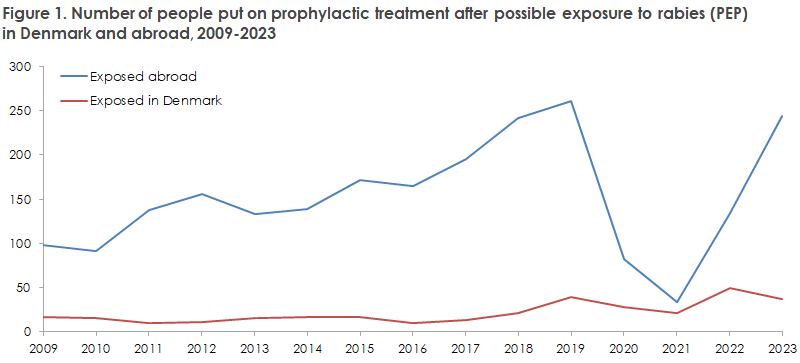No 50b - 2024
Report on Rabies Prophylaxis and Rabies Examinations in Denmark in 2023
Report on Rabies Prophylaxis and Rabies Examinations in Denmark in 2023
For a detailed description of rabies Post-Exposure Prophylaxis (PEP) and animals tested for rabies in Denmark in 2023, please refer to the annual report.
Continued increase in the number of rabies prophylaxis after exposure abroad
After the lockdown caused by COVID-19 and the resulting reduced travel activity, there was a sharp decline in the number of PEP treatments in 2020/2021. The curve turned upward in 2022, and in 2023, there was a continued increase in the number of individuals put on PEP treatment after possible exposure to rabies infection abroad. As in 2022, a large portion of those put on rabies PEP treatment after bites had traveled to Thailand and Turkey, but in 2023, many had also traveled to India. None developed the disease.
In 2023, a total of 281 individuals were assessed to have been exposed to possible rabies after animal bites and were put on rabies PEP treatment. The majority (n=244, 87%) were bitten by animals abroad.
The number of individuals put on treatment after possible exposure to rabies in Denmark decreased in 2023 compared to 2022 but is still above the level in 2020/2021. Unlike in 2022, where imported pets from Ukraine accounted for 61% of the cases where people were put on PEP treatment after possible exposure in Denmark, bats were the main cause of possible exposure in most cases in 2023 (32 of the 37 cases with possible exposure in Denmark). Four people were bitten by illegally imported, unvaccinated dogs. One person received PEP after being scratched and drooled on by an aggressive cat that had been seen carrying a dead bat the week before. This is normally not an indication for PEP, as mammals infected with bat rabies are considered "dead-end hosts" with a very low risk of transmitting the infection further.
However, as a precaution, PEP is given if the mammal has been laboratory-confirmed to have bat rabies. Bites/scratches from dogs, cats, or other mammals in Denmark should only lead to PEP if there is suspicion that the animal may actually have rabies (illegally imported, or contact in the form of bites/scratches/close play with another illegally imported animal). Conversely, all penetrating bites/scratches from bats should result in PEP.

Poor access to rabies immunoglobulin abroad
Among the 244 individuals who were exposed to possible rabies infection abroad, only 47% received HRIG, about half of them only after arriving in Denmark. This shows that it is still difficult to obtain HRIG in many countries, and it may therefore be worth considering to suggest rabies prevention as part of travel vaccinations when advising people traveling to countries where rabies is endemic.
Child in Canada and teacher in the USA died of rabies after contact with bats
Rabies kills 70,000 people worldwide each year. Most are due to dog bites in Africa and Asia. In Europe and North America, rabies deaths are rare, but when they occur, bat bites are often the cause. In September 2024, a Canadian child died of rabies after being bitten by a bat while sleeping, and in November 2024, a teacher died after being bitten by a bat while trying to chase it out of a classroom. Neither received PEP. In Europe, all bats are insectivorous, and only other lyssaviruses, including EBLV, are found in bats. In America, only classic rabies is found in bats, and some bat species are blood-sucking. These two cases serve, regardless of where in the world one is, as a reminder of the importance of seeking medical evaluation after close contact with bats, as rabies does not show symptoms until it is too late.
Rabies in animals
Denmark has been free of classic rabies since 1982, while European bat rabies is considered endemic in Danish bats. In 2023, a cat and 43 bats were tested for classic rabies and/or bat rabies.
Thirty of the 43 bats were submitted due to suspicion of rabies, and 13 bats were submitted as fallen wildlife. All tests were negative.
Classic rabies is endemic in Greenland, where arctic foxes regularly spread the infection to other mammals. In 2023, three out of four tested arctic foxes in Greenland were positive for classic rabies.
(S. Voss, S. Cowan, M. Wessman, Department of Infectious Disease Epidemiology and Prevention, T.B. Rasmussen, Department of Virus and Microbiological Special Diagnostics)